| What's new in MaxL? |
The MaxL Language has its own grammar that you use to create statements.
In this document, the syntax for the MaxL language is illustrated using railroad diagrams.
The MaxL grammar is case-insensitive. Semicolon statement-terminators are required when using the MaxL Shell. However, do not use semicolons at the end of statements passed using Perl functions. Key words of the MaxL grammar are represented in this document in lower-case. Terminals, represented in upper-case, are to be replaced by the appropriate names, numbers, privileges, or strings. For more information about components of MaxL statements, see Language Definition.
* Note: Login is part of the separate command shell grammar, not the MaxL language itself. You can use the login statement with the MaxL Shell, but it is not embeddable in Perl. For Perl, use connect.
Change application-wide settings. Permission required: Application designer.
Switch to key-phrase explanations
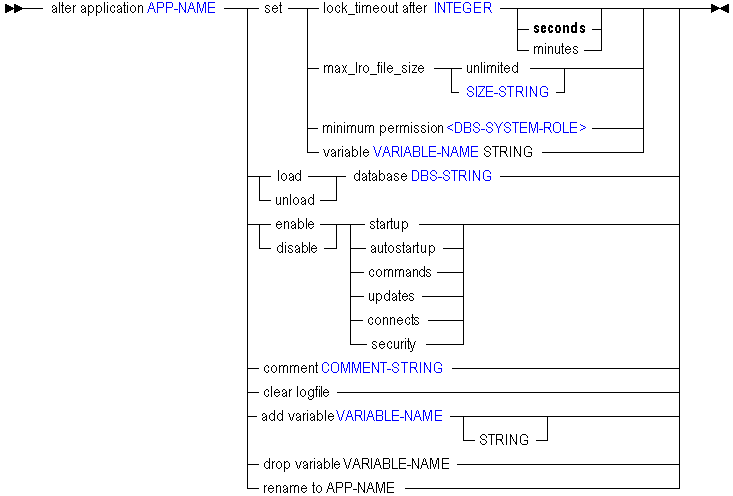
alter application Sample set minimum permission read;
Grants all users read access to all databases in the Sample application. Users can retrieve data values and run report scripts.
alter application Sample disable commands;
Prevents all users from making requests to the application scope. Use this statement before performing application-wide update and maintenance operations.
alter application Acme set variable Current_month July;
Assigns the string value July to the substitution variable "Current_month." "Current_month" may be referenced by calculations in the Acme application.
| Note on Semicolons: Examples in this document follow the syntax requirements of the MaxL Shell. Semicolon statement-terminators are required by the shell, but not by the MaxL language. Therefore, terminate statements with semicolons when using the MaxL Shell, but not when issuing MaxL statements via Perl functions. |
Change database-wide settings. Permission required: Database designer.
Switch to key-phrase explanations
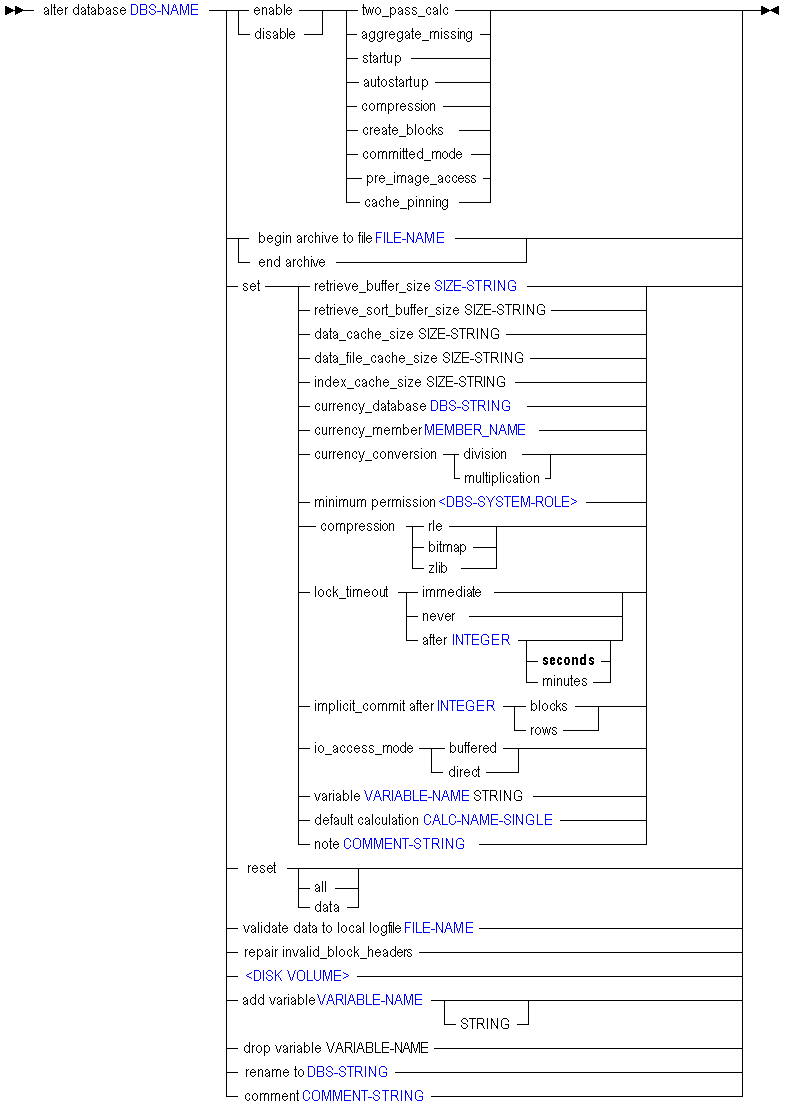
alter database Sample.Basic enable cache_pinning;
Locks database cache pages in physical memory so that the operating system will not page them out while the database is still using them.
alter database Sample.Basic disable two_pass_calc;
Prevents recalculation (after a default calculation) of members tagged as Two Pass.
alter database Sample.Basic set disk volume c file_type index;
Changes the storage settings for Sample Basic so that the alternate disk volume specified as the C: drive stores only index files.
alter database Sample.Basic set lock_timeout after 120;
Changes the number of seconds to wait for blocks to be unlocked. If a transaction request is made which cannot be granted in 120 seconds, the transaction is rolled back until a lock can be granted.
Add a disk volume definition if you want to allocate storage across multiple volumes, or restrict space used on a volume. You can allocate storage for index files, data files, or both.
If no disk volume is defined, data and index files are stored in the database directory (for example, $ARBORPATH/app/sample/basic).
File_size is the maximum size an index or data file may attain. Default = 2G; minimum = 8192K (8M).
Partition_size is the maximum amount of disk space allocated to the volume. Default = unlimited.

Rename a group or change the comment that describes the group. Permission required: create_user.
Switch to key-phrase explanations

alter group NewGroup rename to Recruit;
alter group Recruit comment 'This group is for the newly hired';
Change the state of the Hyperion Essbase server. Start and stop applications, delete application log files, manipulate system-wide variables, manage password and login activity, disconnect users, kill processes, back up the security file, and shut down the server. Permission required: supervisor.
Switch to key-phrase explanations
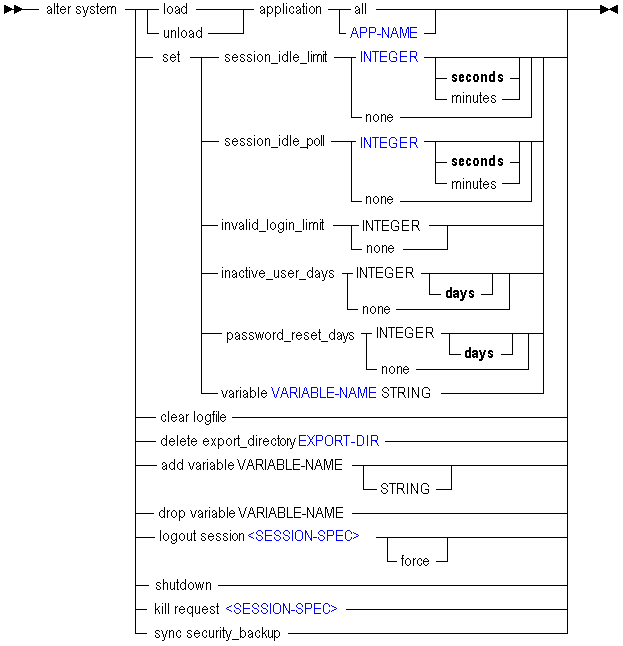
alter system unload application Sample;
Stops the Sample application, if it is currently running.
alter system logout session by user Fiona;
Disconnects Fiona from any applications or databases to which she is connected.
Note: To log out a user, log out the sessions owned by that user.
alter system set password_reset_days 10;
Specifies that all users will be prompted after 10 days to change their passwords. The day count for any user is reset when the user changes the password or is edited or re-activated by a supervisor.
A session is a single user connection to Essbase. The session can be identified by keywords and names indicating context, or by a unique session ID number.
A request is a query sent to Essbase by a user or by another process; for example, starting an application, or restructuring a database outline. Only one request at a time can be processed in each session.
If a session is processing a request at the time that an administrator attempts to terminate the session, the administrator must either terminate the request first, or use the force kewyord available with alter system to terminate the session and the current request.

Add or remove a user to or from a group. Rename a user. Change the comment that describes a user. Enable or disable a user account. Change a user's password, or specify whether it should expire. Permission required: create_user.
Switch to key-phrase explanations
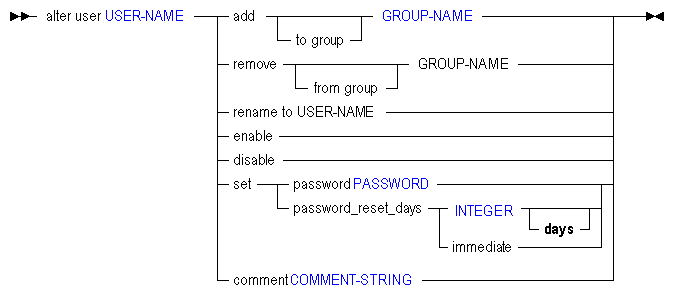
alter user Fiona add to group Newhires;
Assigns Fiona to a group called Newhires. This gives Fiona the same minimum privileges as those defined for the group.
alter user Fiona enable;
Enables user Fiona to log in again.
alter user Fiona set password_reset_days immediate;
Requires the user Fiona to change her password at the next login.
Create or re-create an application, either from scratch or as a copy of another application on the same system. APP-NAME must consist of 8 or fewer characters. Avoid spaces and special characters when naming applications and databases. Application names are case-sensitive.
Permission required: create_application. To copy an application, designer permission on the source application is additionally required.
Switch to key-phrase explanations

create application Sample comment 'This is a test application.';
Creates a new application called Sample with an associated comment.
create application Newsamp as Sample;
Creates an application called Newsamp which is a copy of the application Sample.
create or replace application Sample;
Creates an application called Sample. If an application named Sample already exists, it is overwritten.
Create, replace, or copy a stored calculation.
Permissions required: Database designer to create database-level calculations. Application designer to create application-level calculations. When creating
database-level calculations, this statement requires the database to be started.
A stored calculation can be associated with an application/database, or with
an application only. To create an application-level calculation, use two tokens
for CALC-NAME. To create a database-level calculation, use three tokens. See
CALC-NAME for more details.
Note: Calculations created using MaxL must be valid. For information about
calculation syntax, see the Database Administrator's Guide.
Switch to key-phrase explanations

create or replace calculation sample.basic.Accts 'SET UPDATECALC ON; CALC DIM(Accounts);' ;
Creates a calculation named Accts that is associated with sample.basic.
create calculation sample.basic.Accts2 as app.db.Accts
Creates a calculation named Accts2 on sample.basic that is a copy of another database's calculation named Accts.
Create or re-create a regular or currency database. Optionally create the database as a copy of another database on the same system. DBS-NAME must consist of 8 or fewer characters. Avoid spaces and special characters when naming applications and databases.
Permission required: Application designer. To copy a database, designer permission on the source database is additionally required.
Switch to key-phrase explanations

create or replace database Sample.Basic comment 'This is a test.';
Creates a database called Basic within the Sample application. If a database named Basic within the Sample application already exists, it is overwritten.
create database Sample.New as Sample.Basic;
Creates a database called New within the Sample application that is a copy of the database Basic within the Sample application.
create currency database Sample.Interntl;
Creates a currency database called Interntl within the Sample application.
Create or re-create a database security filter, either from scratch or as a copy of another filter on the same system.
Filters control security for database objects. Use grant to assign filters to users and groups.
Minimum permission required: Database designer.
Note: Filters created using MaxL must be valid. For information about
filter syntax, see the Database Administrator's Guide.
Switch to key-phrase explanations

MEMBER-EXPRESSION must be enclosed in single quotation marks. It can be a comma-separated list.
create filter sample.basic.filt1 read on 'Jan, sales', no_access on '@CHILDREN(Qtr2)';
Creates a filter to restrict privileges to Sample Basic as follows: gives read-only access to the intersection of Jan and sales (sales data for January only); blocks access to children of Qtr2 (April, May, and June).
create or replace filter sample.basic.filt1 read on 'Sales, @ATTRIBUTE(Bottle)';
Creates a filter (or changes an existing filter) to restrict privileges to Sample Basic as follows: gives read-only access to sales data for products packaged in a bottle (product base dimension members associated with the Bottle attribute member).
Create or re-create your own registered Hyperion Essbase function, using a Java method.
Minimum permission required: Application designer to create a local (application-level) function. Supervisor to create a global (system-level) function.
Process to follow:
To use this feature, you must have selected to install the Java Virtual Machine with Hyperion Essbase.
To create a global or system-level function, use a single name for FUNC-NAME. For example, '@COVARIANCE'.
To create a local or application-level function, use MaxL's double naming convention for FUNC-NAME. For example, Sample.'@COVARIANCE'. The second token must be enclosed in single quotation marks because it contains a special character.
Switch to key-phrase explanations

CREATE FUNCTION '@COVARIANCE' AS 'com.hyperion.essbase.calculator.Statistics.covariance' SPEC '@COVARIANCE (expList1, expList2)' COMMENT 'computes covariance of two sequences given as expression lists';
Create or re-create a group, either from scratch or as a copy of another group.
Switch to key-phrase explanations

create group Level_1 as Newhires comment 'Copy of Newhires';
Creates a group called Level_1 that is a copy of the existing group Newhires.
Create on the database a location alias identifying a host name, database, user name, and password. Location aliases provide
a shorthand way of referencing login information for other Hyperion Essbase databases. Minimum permission required: Database designer.
Note: Location aliases created using MaxL must be valid. For information about
location aliases, see the Database Administrator's Guide.
This statement requires the database to be started.
Switch to key-phrase explanations

create location alias EasternDB from Sample.Basic to East.Sales at Easthost as Fiona identified by sunflower;
Creates a location alias called EasternDB on Sample.Basic which represents the following login information:Location aliases are used by the @XREF function for cross-database calculations.
- server = Easthost
- application = East
- database = Sales
- user name = Fiona
- password = sunflower
Create or re-create your own Hyperion Essbase macro as your chosen combination of existing calculation functions or macros. This statement registers the new macro with the Essbase custom-defined function and macro catalog.
Minimum permission required: Application designer to create a local (application-level) macro. Supervisor to create a global (system-level) macro.
To create a global (system-level) macro, use a single name for MACRO-NAME. For example, '@COVARIANCE'.
To create a local (application-level) macro, use MaxL's double naming convention for MACRO-NAME. For example, Sample.'@COVARIANCE'.
Switch to key-phrase explanations
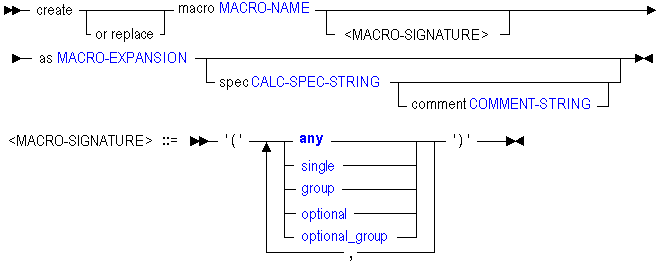
create macro Sample.'@COVARIANCE'(single, single) as '@COUNT(SKIPMISSING,@RANGE(@@S))' spec '@COVARIANCE (expList1, expList2)' comment 'Computes covariance of two sequences given as expression lists';
Switch to key-phrase explanations
Create or validate a partition definition between two databases. Permission required: Database designer at both sites. The first DBS-NAME is the local database, and the second DBS-NAME is the remote database. Creating a partition to the remote site means the current database is the source. Creating a partition from the remote site means the current database is the target.
Multiple area specifications are allowed, provided they are separated by whitespace. Multiple mappings are allowed, provided they are separated by whitespace. All area aliases used in a mapping should be associated with the target, and the direction of the mapped clause should go from source to target.
Note: Partitions created using MaxL must be valid. To validate a partition, use the validate only clause. For information about partition definitions, see the Database Administrator's Guide.
Select the type of partition to create:
Create or validate a transparent partition definition between two databases. A transparent partition allows users to manipulate data that is stored in a target database as if it were part of the source database. The remote data is retrieved from the data source each time that users at the data target request it.
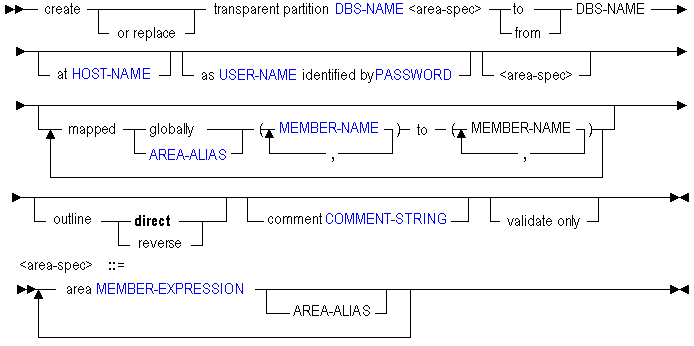
create or replace transparent partition sampeast.east
area '@CHILDREN("Eastern Region"), @CHILDREN(Qtr1)' sourceArea
to samppart.company at localhost
as partitionuser identified by 'password'
area '@CHILDREN(East) @CHILDREN(Qtr1)' targetArea;
Creates a transparent partition between the source, sampeast.east, and the target, samppart.company. The partition is defined only for the areas specified by the area aliasessourceAreaandtargetArea.
create or replace transparent partition source.source
area 'DimensionA' sourceAreaA
area 'DimensionB' sourceAreaB
to target.target at localhost
as admin identified by 'password'
area 'ParentMemberA' targetAreaA
area 'ParentMemberB' targetAreaB
mapped targetAreaA (ChildA) to (Child_a)
mapped targetAreaB (ChildB) to (Child_b)
;
Creates a partition from database Source to database Target where the partitioned areas between them are DimensionA and DimensionB on the source, corresponding to ParentMemberA and ParentMemberB (respectively) on the target. Differences in member names between the two partitioned areas are resolved during the partition creation, using the mapped clauses. Area aliases are used after each area specification, so that members can be mapped specifically for each area.
Create or validate a replicated partition definition between two databases. A replicated partition copies a portion of the source (or master) database to be stored in a target database. Users can access the target database as if it were the source. The administrator must periodically refresh the target data from the source data.
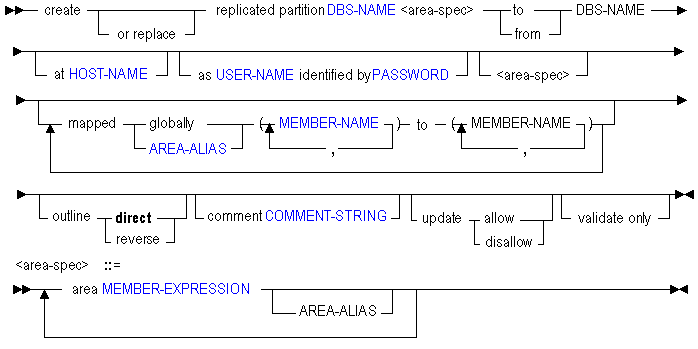
create or replace replicated partition source.source
area 'DimensionA' sourceAreaA
area 'DimensionB' sourceAreaB
to target.target at localhost
as admin identified by 'password'
area 'ParentMemberA' targetAreaA
area 'ParentMemberB' targetAreaB
mapped targetAreaA (ChildA) to (Child_a)
mapped targetAreaB (ChildB) to (Child_b)
;
Creates a partition from database Source to database Target where the partitioned areas between them are DimensionA and DimensionB on the source, corresponding to ParentMemberA and ParentMemberB (respectively) on the target. Differences in member names between the two partitioned areas are resolved during the partition creation, using the mapped clauses. Area aliases are used after each area specification, so that members can be mapped specifically for each area.
create or replace replicated partition sampeast.east
area '@IDESCENDANTS("Eastern Region"), @IDESCENDANTS(Qtr1)'
to samppart.company at localhost
as partitionuser identified by 'password'
area '@IDESCENDANTS(East) @IDESCENDANTS(Qtr1)'
update disallow;
Creates a replicated partition from an area in the source database, sampeast.east, to an area in the target database, samppart.company.
create or replace replicated partition sampeast.east
area '@IDESCENDANTS("Eastern Region"), @IDESCENDANTS(Qtr1)'
to samppart.company at localhost
as admin identified by 'password'
area '@IDESCENDANTS(East) @IDESCENDANTS(Qtr1)' foo
mapped foo (Year) to (Yr)
update allow validate only;
Validates the syntax of a replicated partition you might want to create. To create the partition after checking validity, simply remove the validate only phrase. For an explanation of foo as used above, see the definition for AREA-ALIAS.
Create or validate a linked partition definition between two databases. A linked partition enables users to navigate from one data value in one database, to a subset of another database. The two databases may contain very different outlines.
For example, if a Spreadsheet Add-in user clicks a database cell that contains a link to another database, a new sheet opens displaying the dimensions in the second database. The user can then drill down into the linked database's dimensions.
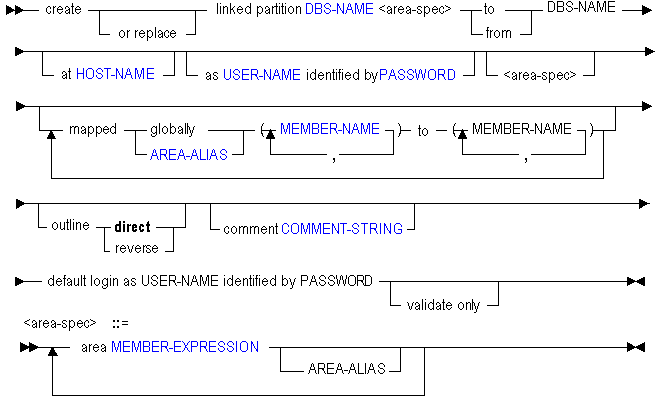
create or replace linked partition sampeast.east
area '@DESCENDANTS("Eastern Region"), @DESCENDANTS(Qtr1)'
to samppart.company at localhost
as partitionuser identified by 'password'
area '@DESCENDANTS(East) @DESCENDANTS(Qtr1)'
area '"Region 9020" "FLD Other"'
default login as appdesigner identified by 'password';
Create or re-create a user, either from scratch or as a copy of another user. Users can be created to log in using Essbase security, or to use external authentication using an outside authentication protocol. Optionally create the Essbase-authenticated user as a member of a group.
Switch to key-phrase explanations
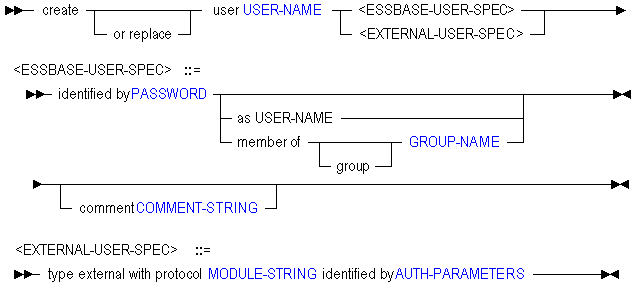
create user Fiona identified by sunflower;
Creates a user called Fiona with the password sunflower.
create user Guest identified by 'password' member of group Visitors;
Creates a user called Guest with the password password, and adds Guest to the group called Visitors. Quotation marks are required because password is a MaxL keyword.
create or replace user Guest identified by 'password' as RecycleMe;
Creates a user called Guest as a copy of an existing user called RecycleMe. If Guest already exists, it is overwritten.
create or replace user Fred type external with protocol 'LDAP' identified by 'cn=Engineers, ou=Groups, dc=yahoo, dc=com@server2';
Creates a user called Fred who is externally authenticated with the Lightweight Directory Access Protocol.
View information about current application-wide settings.
Switch to key-phrase explanations

display application;
Displays information about all applications on the system.
display application Sample;
Displays information about the Sample application.
View a list of stored calculations on the system.
Switch to key-phrase explanations

display calculation;
View information about current database-wide settings.
Switch to key-phrase explanations

display database;
Displays information about all databases on the system.
display database Sample.Basic;
Displays information about the Sample.Basic database.
The values returned for the currency conversion field are numeric, and translate as follows:
| Constant | Value |
| 1 | division |
| 2 | multiplication |
The values returned for the compression field are numeric, and translate as follows:
| Constant | Value |
| 1 | Run-length encoding |
| 2 | Bitmap |
| 3 | ZLIB |
View a list of currently defined disk volume definitions.
Note: to manage disk volumes, use alter database (containing add, drop, and set disk volume).
Switch to key-phrase explanations

display disk volume;
Displays all (if any) disk volumes defined on the system.
display disk volume sample.basic.'vol3/hyperion/essbase';
or
display disk volume sample.basic.C;
Displays information about a particular disk volume definition on Sample.Basic.
The values returned for the file type field are numeric, and translate as follows:
| Constant | Value |
| 1 | Index |
| 2 | Data |
| 3 | Index and Data |
View a specific filter or a list of all filters on the system.
Switch to key-phrase explanations

display filter;
Displays the names of all filters on the system.
Switch to key-phrase explanations
View the filter rows which define database access within a specific filter or all filters.

display filter row sample.basic.filt2;
Displays the row-by-row definition of a filter named filt2 which is associated with Sample.Basic.
View a list of custom-defined functions available globally or to an application. If MaxL shows no application name next to a function in the display output, then that function is global (system-wide). This statement also returns the validation status of an application's local custom-defined function or functions. Minimum permission required: read.
Switch to key-phrase explanations

display function on application sample;
Displays all custom-defined functions associated with the application Sample.
| Column Name | Contents |
application |
Application name(s). |
function |
Registered custom-defined function name(s), as defined by FUNC-NAME in the create function statement. |
class |
The java class before the method, as defined by JAVACLASS.METHOD in the create function statement. |
method |
The java method (at the end of the class), as defined by JAVACLASS.METHOD in the create function statement. |
spec |
Optional Essbase calculator-syntax specification string, as defined by CALC-SPEC-STRING in the create function statement. |
comment |
String as defined by COMMENT-STRING in the create function statement. |
runtime |
Values: TRUE or FALSE. Whether or not the custom-defined function was created with the runtime property. |
state |
The current state of the registered custom-defined function. Values:
|
View a specific group or a list of all groups on the system. To view group membership information, use display user.
Switch to key-phrase explanations

View a specific location alias or a list of all location aliases defined on the system.
Switch to key-phrase explanations

display location alias all;
Displays a list of location aliases defined on the system.
View a list of custom-defined macros available globally or to an application.
Minimum permission required: read.
If MaxL shows no application name next to a macro in the display output, then that macro is global (system-wide).
Switch to key-phrase explanations

display macro on application sample;
Displays all custom-defined macros associated with the application Sample.
| Column Name | Contents |
application |
Application name(s). |
macro |
Macro name(s), as defined by MACRO-NAME in the create macro statement. |
signature |
Macro signature, as defined by the custom-defined macro input parameters in the create macro statement. |
expansion |
Macro expansion, as defined by MACRO-EXPANSION in the create macro statement. |
spec |
Optional Essbase calculator-syntax specification string, as defined by CALC-SPEC-STRING in the create macro statement. |
comment |
String as defined by COMMENT-STRING in the create macro statement. |
state |
The current state of the registered custom-defined macro. Values:
|
View information about a specific partitioned database or all partitioned databases on the system.
Note: if a partition definition is invalid, the same partition may be displayed twice, one time for each half. Each half will show the connection information of the other half.
Switch to key-phrase explanations

display partition all;
Displays information about all partitioned databases defined on the system.
View a list of privileges, calculations, or filters held by users or groups.
Switch to key-phrase explanations

display privilege user Fiona;
Displays the privileges user Fiona has on each database object, including any calculations or filters granted to Fiona.
display privilege group;
Displays privileges held by all groups on the system to all applications and databases on the system.
The values returned for the type field are numeric, and translate as follows:
| Constant | Value |
| 1 | System-level privilege |
| 2 | System-level role |
| 3 | Execute calculation |
| 4 | Filter |
View active login sessions on the current server, application, or database, including:
Switch to key-phrase explanations

display session;
display session on database sample.basic;
View information about current system-wide settings.
Switch to key-phrase explanations

display system;
Displays current password and session management settings.
View a specific user or a list of all users defined on the system. View group membership information.
Switch to key-phrase explanations

display user;
Displays all users on the system and shows whether they are logged in, whether their accounts are enabled, and whether their passwords are set to expire.
display user in group;
Displays the membership information of all groups on the system.
display user in group big_group;
Displays the membership information for a group called big_group.
View a list of substitution variables defined on the system.
Note: to manage substitution variables, use alter database (containing add, drop, and set variable).
Switch to key-phrase explanations

display variable;
Displays a list of all susbstitution variables on the Essbase OLAP server.
Delete an empty application from the system. To remove an application with databases, use cascade. To remove an application that has locked objects in a constituent database, you can use force. Minimum permission required: designer.
Switch to key-phrase explanations

Delete a stored calculation from a database. Minimum permission required: designer.
Switch to key-phrase explanations

drop calculation Sample.basic.calcname;
Deletes a calculation from Sample.basic.
Delete a database from the sytsem. Minimum permission required: Database designer. If the database has outstanding locks, clear them first, or use force to drop with locks.
Switch to key-phrase explanations

drop database Sample.Basic force;
Deletes the database Sample.Basic, even if client users have outstanding locks on Sample.Basic.
Delete a security filter from the database. Minimum permission required: Database designer.
Switch to key-phrase explanations

drop filter sample.basic.filter1;
Deletes the filter called filter1 from the sample.basic database.
Delete a custom-defined function from the system or from an application.
Minimum permission required: Application designer to drop a local (application-level) function. Supervisor to drop a global (system-level) function.
If you drop a custom-defined function after having associated it with an application (using refresh custom definitions), you may have to stop and restart the application for the drop to take effect.
Switch to key-phrase explanations

drop function sample.'@COVARIANCE';
Deletes the function called @COVARIANCE from the Sample application.
Delete a user group from the system. Users belonging to the group are not deleted. Minimum permission required: create_user.
Switch to key-phrase explanations

drop group big_group;
Deletes the group called big_group from the system.
Delete from the database a location alias identifying a host name, application, database, user name, and password. Minimum permission required: database designer.
Switch to key-phrase explanations

drop location alias Main.Sales.EasternDB;
Drops the location alias called EasternDB in the Main.Sales database.
Delete a custom-defined macro from the system or from an application.
Minimum permission required: Application designer to drop a local (application-level) macro. Supervisor to drop a global (system-level) macro.
If you drop a custom-defined macro after having associated it with an application (using refresh custom definitions), you may have to stop and restart the application for the drop to take effect.
Switch to key-phrase explanations

drop macro sample.'@COVARIANCE';
Deletes the macro called @COVARIANCE from the Sample application.
Delete from the system a partition definition between two databases. Database designer privilege for each database is required.
Switch to key-phrase explanations

drop replicated partition Samppart.Company from Sampeast.East at EastHost;
Delete a user account from the system. Minimum permission required: create_user.
Switch to key-phrase explanations

drop user Fiona;
Deletes the user Fiona from the system.
Execute a stored calculation, the stored default calculation (determined by alter database), or an anonymous (non-stored) calculation string.
Minimum permissions required:
A stored calculation can be associated with an application/database, or with an application only. To execute a calculation stored at the application level, you must specify which database to calculate using the syntax 'on database STRING.'
Switch to key-phrase explanations

execute calculation Sample.Basic.calcname;
Calculates the Sample.Basic database using a stored calculation file assocatied with the database.
execute calculation Sample.calcname on database Basic;
Calculates the Sample.Basic database using a stored calculation file assocatied with the application Sample.
execute calculation 'SET MSG ERROR; CALC ALL;' on Sample.basic;
Calculates Sample.Basic using an anonymous (unstored) calculation string.
Export all data, level-0 data, or input-level data, which does not include calculated values.
Export files are stored in the ARBORPATH/app directory on the server.
To use Report Writer, export the data using a report file.
Minimum permission required: Read. This statement requires the database to be started.
To export data in parallel, specify a comma-separated list of export files. The number of threads Hyperion Essbase uses depends on the number of file names you specify.
To export data in column format, use the optional "in columns" grammar.
During a data export, the export process allows users to connect and perform read-only operations.
Switch to key-phrase explanations

export database sample.basic data to data_file 'D:\\fileout','D:\\fileout2','D:\\fileout3';
Exports data concurrently to a list of file names.
export database sample.basic input data
to data_file 'exp_input.exp';
export database sample.basic using report_file "'$ARBORPATH/App/Sample/Basic/asym.rep'" to data_file 'home/month2.rpt';
Note: In the path to the report file in the above UNIX example, double quotation marks are used to allow variable expansion in the single-token FILE-NAME, and single quotation marks are required because there are special characters in the file name.
export database sample.basic using report_file 'Essbase\\App\\Sample\\Basic\\asym.rep' to data_file 'c:\\home\\month2.rpt';
Note: In the file paths in the above Windows example, single quotation marks are required because there are special characters in the file name. Two backslashes ( \\ ) are required by the MaxL Shell to indicate one backslash, because the backslash has a special meaning to the MaxL Shell.
Export linked reporting object catalog information and binary files from a database to a local or server directory, to prepare for backing up, clearing, or migrating data.
A linked reporting object (LRO) is a link to an external cell note, file, or URL. The link can be attached to any data cell in an Essbase database. You can export and re-import LROs locally or on the server.
Minimum permission required: Read. This statement requires the database to be started.
If you do not specify a full path for an export directory to be created on the client or server, MaxL uses your short directory specification (DBS-EXPORT-DIR) as a suffix, and creates the destination export-directory in the ARBORPATH\app directory with a prefix of appname-dbname-. If you do specify a full path, MaxL creates whatever directory you specify.
Switch to key-phrase explanations

Notes:
c:\temp exists, MaxL will create c:\temp\exports, but not c:\temp\exports\to\this\long\path.export database sample.basic lro to server directory '../home/temp/lros';
Exports LRO-catalog information, and binary files if the database has file-type LROs, to a server directory calledhome/temp/lros. The directory contains file-type LROs, if applicable, and the LRO-catalog export filelros.exp. These can be brought back into a database using import lro.
export database sample.basic lro to server directory 'exportedLROs';
Exports LRO-catalog information, and binary files if the database has file-type LROs, to a server directory$ARBORPATH/app/sample-basic-exportedLROs. The directory contains file-type LROs, if applicable, and the LRO-catalog export file namedsample-basic-exportedLROs.exp. These can be brought back into a database using import lro.
export database sample.basic lro to server directory 'D:\\MaxL\\LROexports\\dir';
On Windows, exports LRO-catalog information to a new directorydirunder the existing directory structureD:\MaxL\LROexports. The double backslashes (\\) must be used becasue a single backslash is an escape character to MaxL.
Grant a permission, a filter or a stored calculation to a user or a group.
Granting permissions:
At each level (system, application or database) existing roles are replaced. However, the built-in privileges create_user and create_application are not replaced.
Granting filters:
There may be only one filter per user per database. Therefore, granting a filter replaces any
filters the user may already have on that database.
Granting calculations:
A user or group may have any number of calculations per database. Therefore, granting a calculation adds it to the user or groupѺs list of calculations.
Grant execute any gives the user or group permission to execute all calculations, including the default calculation.
Switch to key-phrase explanations
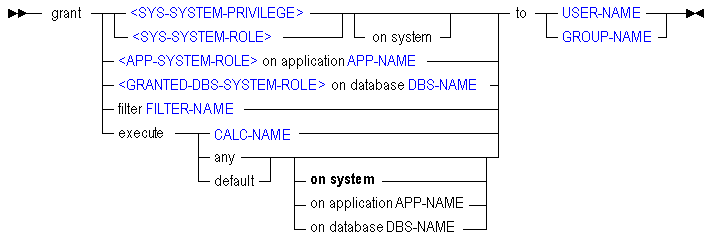
grant no_access to NewGroup;
grant supervisor to Fiona;
grant designer on application Sample to Fiona;
grant read on database Sample.basic to Fiona;
Import data from text or spreadsheet data files, with or without a rules file. To import from a SQL data source, you must connect as the relational user name, and use a rules file.
When using the import statement, you must specify what should happen in case of an error.
Minimum permission required: Write. This statement requires the database to be started.
Switch to key-phrase explanations
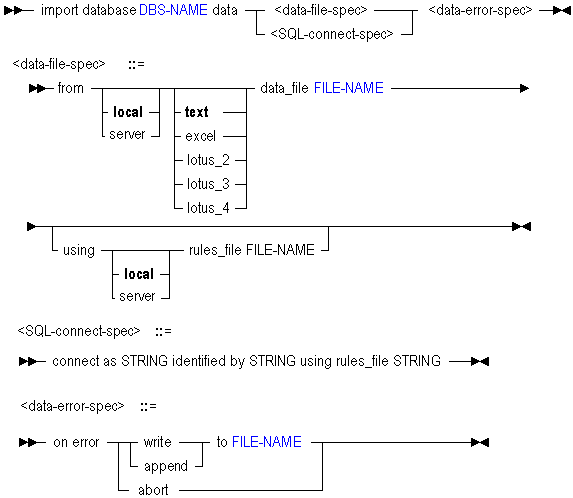
import database sample.basic data from data_file "'$ARBORPATH\\app\\sample\\basic\\calcdat.txt'" on error abort;
import database sample.basic data
from data_file '/data/calcdat.txt'
using rules_file '/data/rulesfile.rul'
on error write to '/logs/dimbuild.log';
Import dimensions from text or spreadsheet data files, using a rules file. To import from a SQL data source, you must connect as the relational user name, and use a rules file.
When using the import statement, you must specify how error logs should be handled.
Minimum permission required: Write. This statement requires the database to be started.
Switch to key-phrase explanations
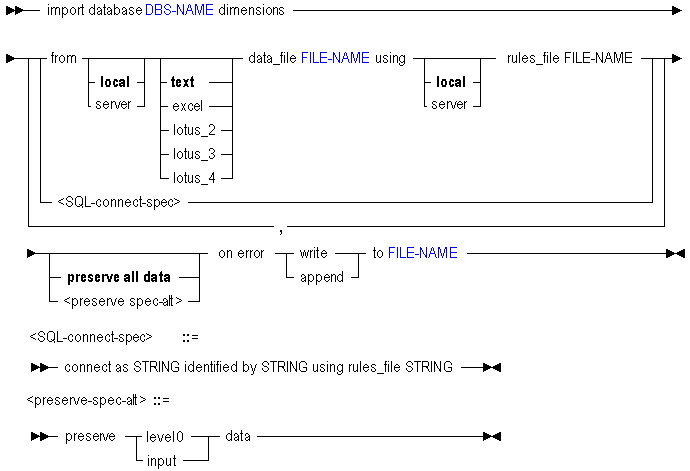
import database sample.basic dimensions
from data_file '/data/calcdat.txt'
using rules_file '/data/rulesfile.rul'
on error append to '/logs/dimbuild.log';
Import linked reporting objects (LROs) from the specified output directory created by export lro. The directory contains an ASCII .exp file containing LRO-catalog information, and LRO binary files (if the database from which LROs were exported contained file-type LROs).
Minimum permission required: Write. This statement requires the database to be started.
The specified import directory must come from the results of the export lro operation. The exported LRO-catalog file contains a record of the LRO file locations, cell notes, or URL text, and database index locations to use for re-importing to the correct data blocks.
Switch to key-phrase explanations

import database sample.basic lro
from server directory 'c:\\essbase\\app\\sample-basic-lros';
import database sample.basic lro
from directory "'$ARBORPATH\\app\\sample-basic-lros'";
import database sample.basic lro
from server directory "'$ARBORPATH/essbase/app/sample-basic-lros'";
From the subdirectory created by export lro in the app directory on the server, both the Windows and UNIX example statements above re-import the LRO-catalog information (and file-type LROs if applicable) that were exported to that location.Note: In the paths in the second two examples, double quotation marks are used to allow variable expansion in the string IMPORT-DIR, and single quotation marks are required because there are special characters in the path name.
Refresh the definitions of custom-defined functions or macros associated with an application, without restarting the application.
This statement re-reads the custom-defined function and macro records on the Agent, and associates newly created functions or macros with the specified application (since the last refresh, or since the last time the application was restarted). Invalidly defined functions and macros are not loaded to the application.
Validation occurs at the application level only, during the refresh (not during creation). There is no validation on the system level.
Switch to key-phrase explanations

refresh custom definitions on application Sample;
Loads all valid, newly created local functions and macros for the application Sample.
Note: a local function or macro must have been created using the double naming convention to indicate application context: see create function or create macro for details.
Synchronize the outlines between partitioned databases. Use this in the event that one outline has undergone changes to dimensions, members, or member properties, and you wish to propagate those changes to the partitioned database.
Switch to key-phrase explanations
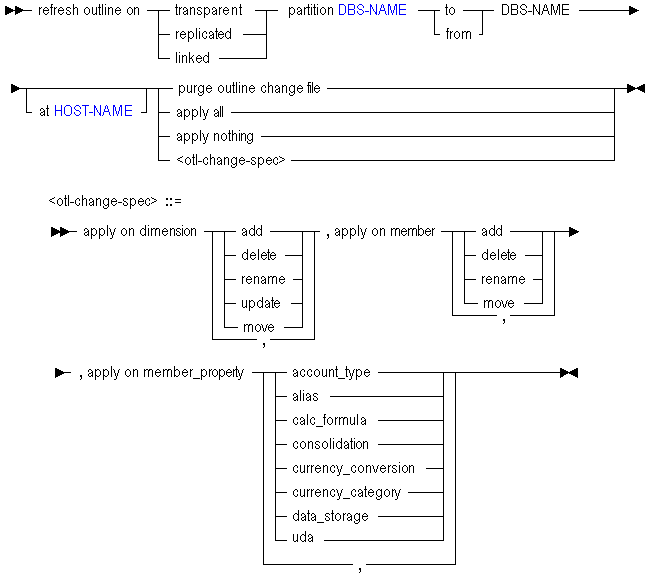
refresh outline on replicated partition sampeast.east to samppart.company apply all;
Refreshes the target outline (for Samppart.company database) with any and all changes made to the source outline (Sampeast.east).
refresh outline on replicated partition Sampeast.east to Samppart.company apply on dimension update, apply on member rename, apply on member_property account_type;
Refreshes the target outline (for Samppart.company database) with changes made to the source outline (Sampeast.east), reflecting the following update to a dimension: a member tagged Accounts was renamed.
Refresh the current replicated-partition database target from the remote (second DBS-NAME) source partition. Database designer privilege for each database is required.
Switch to key-phrase explanations

Copyright 1991-2002 Hyperion Solutions Corporation. All rights reserved.